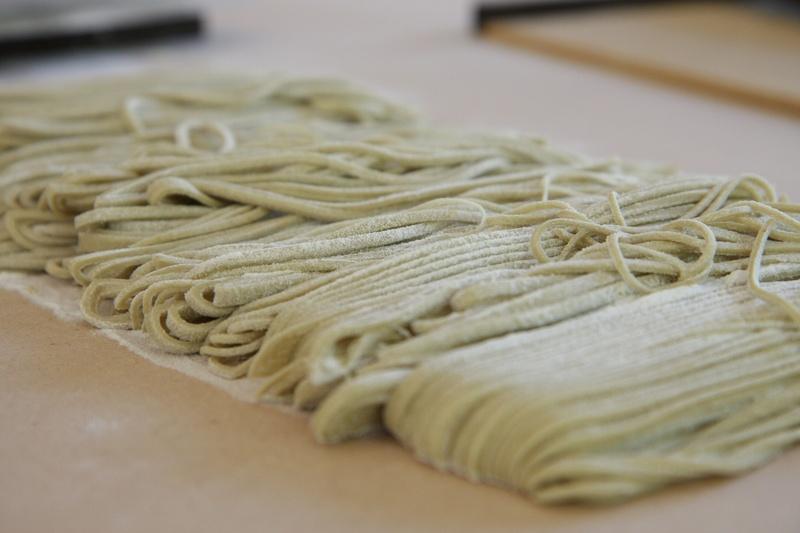George Washington was a big fan of soba and an LA woman believes you should be too
Nothing like a plate of real buckwheat soba noodles.
Izumo, a city in Japan famous for its soba, is getting ready to hold a three day festival celebrating the delicious noodle. Soba noodle is a thin Japanese noodle made from buckwheat, and it can be served hot or cold, straight or garnished, and as a fast-food or specialty dish…and it’s very healthy.
But it turns out the noodle’s main ingredient – buckwheat – isn’t just a Japanese thing. It has a deep connection to America’s founding fathers.
Sonoko Sakai grew up in Kamakura, Tokyo, a region known for its soba making. But she said her family didn’t really make soba noodles.
“They all worked with flour but it was making pasta, and making pies and lasagna.”
But Sakai also fondly remembers slurping the tasty noodles with her grandmother. While slurping is considered rude in some cultures, in Japan it’s a necessity.
“The reason why you slurp is not just to make a loud sound, which is kind of fun,” Sakai said, “but it’s because especially if you’re eating it hot for example, you’re slurping it, aerating it, and not only tasting the noodles, its moving into your mouth faster.”
In other words, slow slurpers… need to slurp faster. Or the soba starts to get kind of mushy. “And that,” said Sakai, “is not polite to the chef. So you want to eat noodles quickly.”
Now fast forward from Sakai’s childhood. She moves to the US, becomes a successful film distributor, and after two decades, she felt it the right time to try something new. So in 2010, memories of slurping soba with her grandmother took her back to Japan where she learned to make noodles under soba masters.
Then Sakai returned to the US, determined to make a hearty bowl of soba.
“[But] I was very naïve to think I could just go to Japan, learn how to make soba noodles, come back and make soba,” she remembered. “When I came back and tested some of the flour you can buy at the market, none of them make soba. They’re just not soba grade.”
The buckwheat flour she found in America made soba noodles that lacked taste, chewiness, and most importantly, ”nodogoshi.”
“It’s the feeling and sensation as the first strands of noodles are going through your throat. It’s this sensation this feeling that Japanese people love to experience,” she said.
So Sakai did some research: Where could she find high quality buckwheat – the kind that she used in Japan – to make the best soba?
She found her answer in Washington State, right in the US, the land of mushy, nodogoshi-lacking soba noodles.
“I called the chamber of commerce in Washington state and found out where buckwheat is grown and I actually went to visit some farmers and realized that almost 60 percent of buckwheat that’s grown in Washington states, and that’s in the millions of tons, is imported directly to Japan,” Sakai said.
And the buckwheat that stays in the US, is only used as fertilizer.
It also turns out that not only does Washington State supply buckwheat to Japan; buckwheat actually has a deep connection to another Washington… George.
“Our forefathers Thomas Jefferson and George Washington were the first people to plant buckwheat. They had fields of buckwheat. And if you go back to some old songs like Steven Foster’s “Oh Susanna,” the girl is eating buckwheat cake.
“The buckwheat cake was in her mouth, a tear was in her eye. I am comin' from the South! Susanna don't you cry.”
“Buckwheat use to be a very nourishing food that our ancestors ate in the early days. But something happened,” she said with a laugh, “when industrialization happened. And people started eating industrial wheat. And all those beautiful ancient grains including buckwheat sort of got lost.”
Now, more than two centuries later, Sakai is helping Americans re-discover their own presidential crop by teaching soba workshops all over the US. Her goal is to help people understand how proper soba noodles should be made – and eaten.
“You know,” she joked, “I’ve seen some really bizarre combinations, soba salad combinations
Sakai said a true soba connoisseur would eat the noodles straight, maybe with a light garnish, but not American-style, like in a salad with meat, veggies, and olive oil.
But Sakai isn’t really criticizing anymore because, well, “I actually sometimes enjoy eating a soba salad.”
After all, it’s not one, but two histories and cuisines that are tied together by a strand of soba noodle.
We want to hear your feedback so we can keep improving our website, theworld.org. Please fill out this quick survey and let us know your thoughts (your answers will be anonymous). Thanks for your time!
